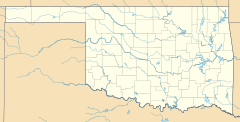Leonard, Oklahoma facts for kids
Quick facts for kids
Leonard
|
|
|---|---|
| Country | United States |
| State | Oklahoma |
| County | Tulsa |
| Area | |
| • Total | 1.51 sq mi (3.91 km2) |
| • Land | 1.51 sq mi (3.91 km2) |
| • Water | 0.00 sq mi (0.00 km2) |
| Population
(2020)
|
|
| • Total | 262 |
| • Density | 173.62/sq mi (67.06/km2) |
| Time zone | UTC-6 (Central (CST)) |
| • Summer (DST) | UTC-5 (CDT) |
| FIPS code | 40-42500 |
Leonard is a small, unincorporated community. This means it's a place where people live, but it doesn't have its own official town government. It's located in the southeastern part of Tulsa County, Oklahoma, in the United States.
In 2020, about 262 people lived in Leonard. This was an increase from 200 people in 2010. Leonard is situated along U.S. Route 64, right where Wagoner County begins. The community mostly supports the farms around it. It's also known for the Leonard Geophysical Observatory nearby.
Contents
History of Leonard
The community of Leonard got its own post office on August 22, 1908. It was started by L.E. Reynolds. The town was named after S. C. Leonard, who was from Detroit, Michigan. Joe Randolph was the very first postmaster, which is the person in charge of the post office.
Education in Leonard
Students living in Leonard attend schools that are part of the Bixby Public Schools district.
Leonard Geophysical Observatory
The Leonard Geophysical Observatory is a special facility located just south of Leonard. It was run by the Oklahoma Geological Survey. This observatory was built in 1960. It was chosen because the area was "seismically quiet." This means there were not many natural earthquakes, making it a good spot to detect very small ground movements.
Why the Observatory Was Built
The facility was originally built by Jersey Production Company in 1960. This company was a part of Standard Oil Company of New Jersey. They used it for researching seismic activity, which is the study of earthquakes and vibrations in the Earth.
In 1965, Jersey Company gave the observatory to Oklahoma University. Later, in 1978, the observatory became part of the Oklahoma Geological Survey. It was then officially named the "Oklahoma Geological Survey Observatory."
Monitoring Nuclear Tests
The observatory played an important role in international agreements. Under the Threshold Test Ban Treaty, signed in 1990 by President George H. W. Bush and Mikhail Gorbachev, the Russian Government was allowed to monitor American underground nuclear tests.
Leonard was one of only three places in the United States where the Russians could set up their equipment for this purpose. They built their own seismograph station next to the Oklahoma Geological Survey Observatory. After seven years, when their mission was complete, they returned the leased land to Oklahoma.
Changes at the Observatory
For many years, the observatory had a staff of two people. They were involved in monitoring earthquakes that happened near Oklahoma. However, in 2015, Austin Holland, the state seismologist, announced that the facility was becoming outdated. He said that the work done at Leonard could now be done at the main Oklahoma Geological Survey office. This office is located on the OU campus in Norman.
It would have cost about $100,000 to update the Leonard facility. Because of this, the state decided to close it permanently in the summer of 2015. The two staff members who worked there were offered new jobs in Norman.



